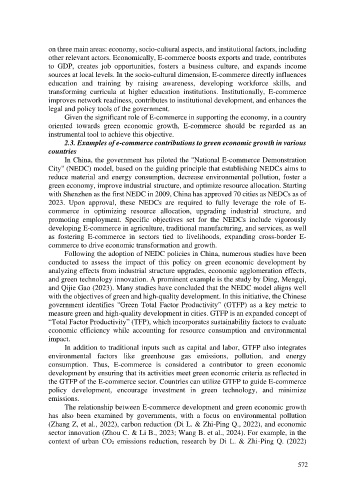Page 580 - Ebook HTKH 2024
P. 580
on three main areas: economy, socio-cultural aspects, and institutional factors, including
other relevant actors. Economically, E-commerce boosts exports and trade, contributes
to GDP, creates job opportunities, fosters a business culture, and expands income
sources at local levels. In the socio-cultural dimension, E-commerce directly influences
education and training by raising awareness, developing workforce skills, and
transforming curricula at higher education institutions. Institutionally, E-commerce
improves network readiness, contributes to institutional development, and enhances the
legal and policy tools of the government.
Given the significant role of E-commerce in supporting the economy, in a country
oriented towards green economic growth, E-commerce should be regarded as an
instrumental tool to achieve this objective.
2.3. Examples of e-commerce contributions to green economic growth in various
countries
In China, the government has piloted the "National E-commerce Demonstration
City" (NEDC) model, based on the guiding principle that establishing NEDCs aims to
reduce material and energy consumption, decrease environmental pollution, foster a
green economy, improve industrial structure, and optimize resource allocation. Starting
with Shenzhen as the first NEDC in 2009, China has approved 70 cities as NEDCs as of
2023. Upon approval, these NEDCs are required to fully leverage the role of E-
commerce in optimizing resource allocation, upgrading industrial structure, and
promoting employment. Specific objectives set for the NEDCs include vigorously
developing E-commerce in agriculture, traditional manufacturing, and services, as well
as fostering E-commerce in sectors tied to livelihoods, expanding cross-border E-
commerce to drive economic transformation and growth.
Following the adoption of NEDC policies in China, numerous studies have been
conducted to assess the impact of this policy on green economic development by
analyzing effects from industrial structure upgrades, economic agglomeration effects,
and green technology innovation. A prominent example is the study by Ding, Mengqi,
and Qijie Gao (2023). Many studies have concluded that the NEDC model aligns well
with the objectives of green and high-quality development. In this initiative, the Chinese
government identifies "Green Total Factor Productivity" (GTFP) as a key metric to
measure green and high-quality development in cities. GTFP is an expanded concept of
“Total Factor Productivity” (TFP), which incorporates sustainability factors to evaluate
economic efficiency while accounting for resource consumption and environmental
impact.
In addition to traditional inputs such as capital and labor, GTFP also integrates
environmental factors like greenhouse gas emissions, pollution, and energy
consumption. Thus, E-commerce is considered a contributor to green economic
development by ensuring that its activities meet green economic criteria as reflected in
the GTFP of the E-commerce sector. Countries can utilize GTFP to guide E-commerce
policy development, encourage investment in green technology, and minimize
emissions.
The relationship between E-commerce development and green economic growth
has also been examined by governments, with a focus on environmental pollution
(Zhang Z, et al., 2022), carbon reduction (Di L. & Zhi-Ping Q., 2022), and economic
sector innovation (Zhou C. & Li B., 2023; Wang B. et al., 2024). For example, in the
context of urban CO₂ emissions reduction, research by Di L. & Zhi-Ping Q. (2022)
572

